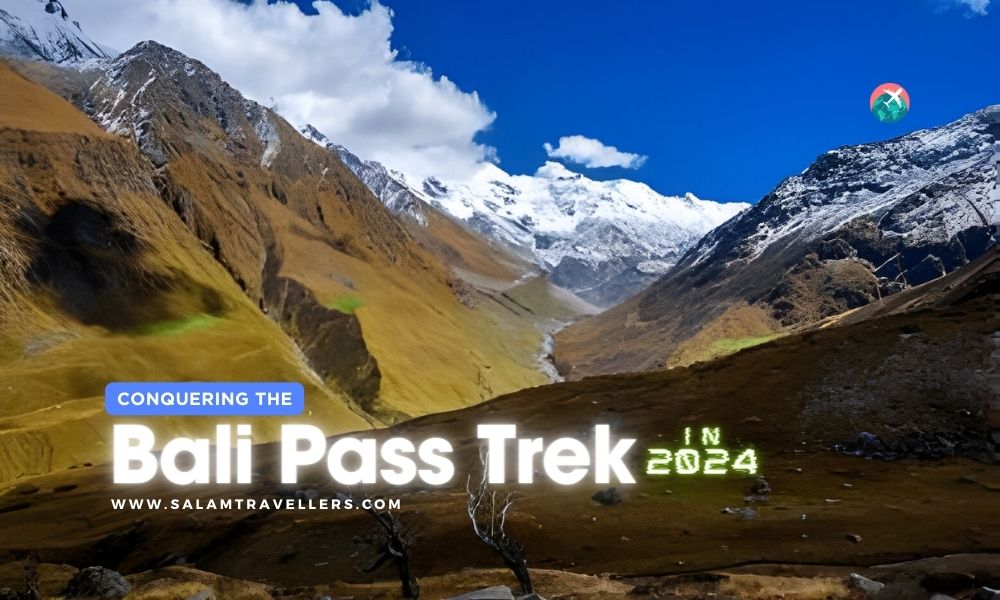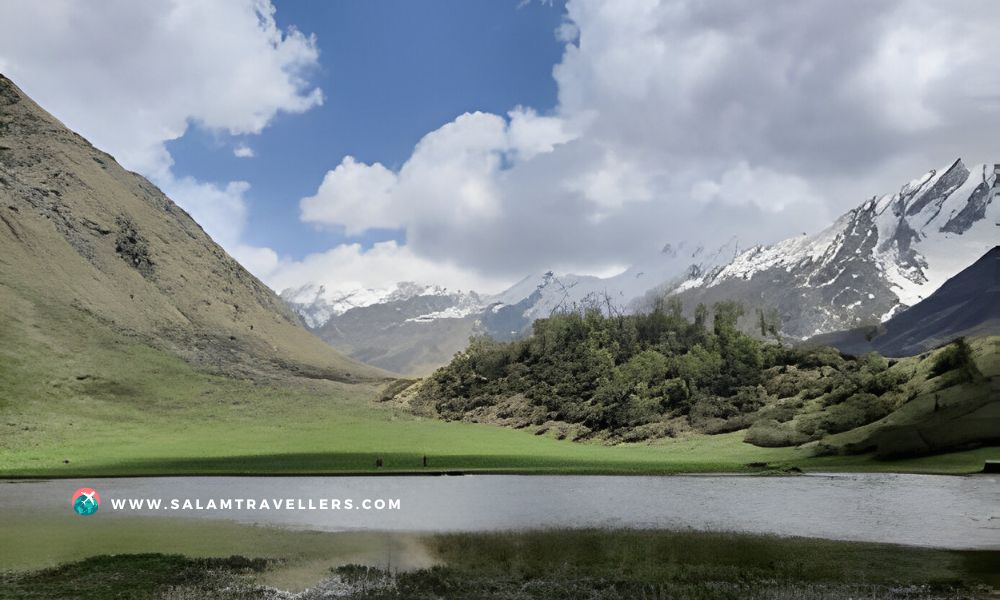
The Bali Pass Trek is located in the Garhwal region of Uttarakhand, India. Spanning approximately 40 km, it starts from the Yamunotri Valley and passes through the Bali Pass to end at Har ki Doon Valley.
The trek begins at an altitude of around 8,000 ft. near the village of Sankri and climbs up to a maximum altitude of 15,700 ft. at the Bali Pass before descending to 11,000 ft. at Har ki Doon. Along the way, the trail passes through dense forests, alpine meadows, moraine ridges, and several mountain streams.
Some of the highlights along the Bali Pass trekking route include the Yamunotri temple, Ruinsara Tal Lake, Bali Pass base camp, and Vasuki Tal Lake. Trekkers need around 5-6 days to complete the trek at a comfortable pace. The changing landscapes and views of the Himalayan peaks, like Swargarohini, make this an unforgettable high-altitude trek.
Also read: Top 10 Treks of Uttarakhand
History and Significance of the Bali Pass Trek

The Bali Pass trek follows an ancient trade route between the Yamunotri Valley in Uttarakhand and the Har ki Doon Valley in the Garhwal Himalayas. This high-altitude mountain pass has been used by traders, shepherds, and pilgrims for centuries to cross between the two valleys across the Great Himalayan Range.
The Bali Pass trek was established in the early 19th century after the Gurkhas invaded Garhwal and opened trade routes across the Himalayas. However, the pass was used much earlier by shepherds and pilgrims traveling to the holy Yamunotri shrine, the source of the Yamuna river and one of the most revered pilgrimage sites for Hindus. Local legends say that even the Pandavas crossed Bali Pass during their exile, as mentioned in the Mahabharata epic.
Situated at an altitude of 4800 meters, Bali Pass holds great historical and cultural significance, connecting the people and cultures of the two valleys. Control of the pass has shifted over time between kingdoms. The pass derives its name from the village of Bali, located on the route of the trek from Yamunotri to the pass.
Also read: The Brahmatal Trek
Trekking Trail and Route Details

The Bali Pass trek typically takes 6-7 days to complete and covers a total distance of around 90 km. The trail passes through beautiful alpine meadows, rocky moraine, and several high mountain passes along the way.
The Bali Pass trek route starts from the village of Maneybhanjyang and follows the Rishi Khola river valley before climbing up to the settlement of Dharamshala. From here, the trail makes a steep climb to the Bali Pass (5,300 m), which offers stunning views of the surrounding peaks like Api, Saipal, and Nampa.

Some of the notable camps along the Bali Pass trek route are:
- Dharamshala camp (3,600 m) – Offers great views of Mukut Himal and Nampa Peak.
- Bali Pass high camp (4,800 m) – Situated just below the Bali Pass with excellent views of the pass.
- Rampur camp (2,300 m) – Located by the river with open meadows around.
- Sipkharka camp (3,240 m) – A large open meadow with views of several 6,000 m+ peaks.
- Yamarkhar Lake camp (4,500 m) – Next to the stunning turquoise-blue Yamarkhar Lake.
The major mountains visible from the trail include Api Peak (7,132 m), Saipal Peak (7,031 m), Nampa Peak (6,957 m), Mukut Himal (6,290 m), and many more unnamed 6000 m+ peaks. The route offers non-stop dramatic Himalayan scenery throughout.
Also read: Kedarkantha Trek
Difficulty and Best Time for the Trek

The Bali Pass trek is considered moderately difficult. The trek involves crossing steep ascents and descents, with the highest point being the Bali Pass at an elevation of 16,240 ft. Trekkers require a good level of fitness and acclimatization to high altitudes to complete the trek.
The best time for the Bali Pass trek is from May to October. During these months, the weather is more stable and the route is more accessible.
Also read: Friendship Peak Trek

Some key challenges trekkers may face on the Bali Pass trek are:
- The high elevation can cause altitude sickness if not properly acclimatized. Symptoms like headaches, nausea, and shortness of breath are common.
- The weather can change suddenly in the high mountains. Trekkers may encounter rain, snow, or high winds even during the best seasons. Proper gear is essential.
- The steep ascents and descents can be physically exhausting. Trekkers should have good cardio fitness and endurance. Taking the ascents slowly is key.
- River crossings can be dangerous during high water levels. Care should be taken to cross with guides at safe points.
- Accommodation is very basic, with small tea houses or tents for camping. Trekkers should be prepared for rough conditions.
With proper preparation and reasonable fitness levels, the Bali Pass trek is an achievable and hugely rewarding Himalayan adventure. The stunning mountain scenery makes the challenges worth it.
Also read: Nag Tibba Trek
Bali Pass Trek in 2024

The year 2024 is expected to be an exciting time for trekkers looking to take on the Bali Pass trek. This classic Himalayan trek connecting the Har ki Doon and Yamunotri Valleys is likely to see some changes and developments to enhance the experience for trekkers.
Also read: Kodachadri trek
Route Developments

Some key developments expected on the Bali Pass trek route in 2024 include:
- Upgrades to existing campsites along the route will add more amenities and facilities. This will allow for a more comfortable camping experience.
- Improved trail maintenance and route marking make navigation easier, especially at high altitudes and tricky sections.
- Potential rerouting of certain sections that are prone to landslides or avalanches. Safety will be a top priority.
- Addition of more pitstops, resting areas, and viewpoints along the route for trekkers to catch their breath and enjoy the scenery.
Also read: Beas Kund Trek
Special Events

To commemorate the new trekking season in 2024, some special events and celebrations will likely be organized, including:
- A Bali Pass Trek opening ceremony event was held at the trailhead in Sankri village. This will bring together locals, guides, and trekking groups to kick off the season.
- Cultural programs showcase local music, dance, food, and customs at campsites along the route. This provides trekkers with an immersive experience.
- Guided sunrise or sunset treks are offered on special days to view the mountains at the golden hour.
- Potential contests or challenges, like photography competitions, could engage trekkers.
- There are special festivities in nearby villages like Har ki Doon that trekkers can join.
What to Pack

When planning for the Bali Pass Trek hike, make sure to include the necessary clothing, gear, equipment, and medications. Here are some ideas for what to pack.
Clothing
- Base layers – Thermal inners and t-shirts to wick away sweat and keep you warm. Synthetic fabrics, or merino wool, are the most effective.
- Mid-layers – Fleece jackets and pants for insulation.
- Outer shell – Waterproof and windproof jacket and pants to protect from the elements. Breathable fabrics like GoreTex are ideal.
- Socks – Woolen trekking socks. Bring extra pairs.
- Gloves – Warm, waterproof gloves.
- Hat and scarf – For sun protection and warmth.
Gear
- Backpack – At least 40L capacity. Ensure it fits you well.
- Trekking poles – Helpful for navigating steep ascents and descents.
- Sleeping bag – Rated for sub-zero temperatures.
- Headlamp – With extra batteries.
- Water bottles – At least 3 liters capacity. Insulated bottles help keep liquids from freezing.
- Sunglasses – With 100% UV protection.
Equipment
- Hiking boots – Waterproof, stiff, high ankle support boots already broken in.
- Crampons – For icy terrain.
- Gaiters – Keep snow and debris out of boots/socks.
Medicines
- Diamox – Helps with acclimatization and altitude sickness. Bring enough to last the whole hike.
- Pain medications – Ibuprofen, acetaminophen, etc.
- Blister treatment – Moleskin, bandages, antibiotic ointment.
- Digestive medications – Antacid, anti-diarrheal, etc.
- Others – Prescription meds, personal medications, etc.
Pack light but include all essentials for safety and comfort in the harsh conditions on the Bali Pass trek.
Also read: Valley of Flowers Trek
Permits and Guides
The Bali Pass trek requires certain permits that must be obtained in advance of the trek. The key permits required are:
- Forest Entry Permit: This permit allows entry into the protected forest areas along the trek. It can be obtained from the District Forest Officer of Pithoragarh district.
- Camping Permit: Required for setting up campsites during the trek. Can be obtained along with the Forest Entry permit.
It is highly recommended to hire local guides and porters for the Bali Pass trek. The guides are essential to navigate through the high-altitude trekking trail. They also arrange camping logistics and porters and help with permit procurement. Some things to consider when hiring a guide are:
- Hire certified and experienced guides: There are many freelance guides available near the trek start points. Ensure they have certification and expertise in high-altitude trekking. Ask for recommendations and reviews.
- Discuss costs and inclusions upfront: Clarify payment terms and costs for guides, porters, accommodation, food, etc. Agree on inclusions like permits, camping gear, insurance, etc.
- Hire porters to carry the load: The Bali Pass trek gains significant altitude, so porters are recommended to carry the load. Agree on payment, maximum load, insurance, etc. for porters.
- Book guides in advance: Hire a guide 1-2 months in advance, especially for peak seasons. This gives them time to plan better.
Also read: Chopta Trek
Final Assessment
The Bali Pass trek in 2024 promises to be more well-equipped, safer, and filled with celebratory vibes for adventure seekers to enjoy. With stunning Himalayan scenery as always, it will continue to be a bucket-list trekking experience.
Stay tuned for more adventure guides from Salam Travellers.



